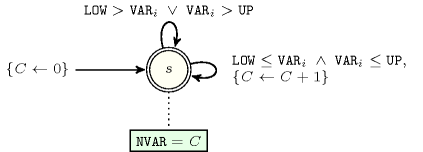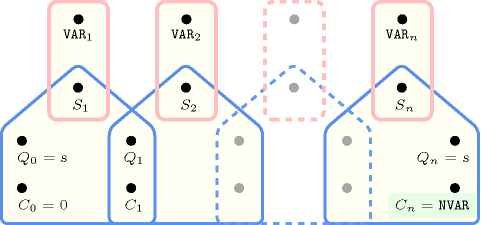5.25. among_interval
| DESCRIPTION | LINKS | GRAPH | AUTOMATON |
- Origin
- Constraint
- Arguments
- Restrictions
- Purpose
is the number of variables of the collection taking a value that is located within interval ].
- Example
-
The constraint holds since we have 3 values, namely and 4 that are situated within interval .
- Typical
- Symmetries
Items of are permutable.
An occurrence of a value of that belongs to (resp. does not belong to ) can be replaced by any other value in ) (resp. not in ).
- Arg. properties
Functional dependency: determined by , and .
Contractible wrt. when .
Contractible wrt. when .
Aggregate: , , , .
- Remark
By giving explicitly all values of the interval the constraint can be modelled with the constraint. However when is a large quantity the constraint provides a more compact form.
- See also
generalisation: ( in replaced by ).
- Keywords
characteristic of a constraint: automaton, automaton with counters.
constraint arguments: pure functional dependency.
constraint network structure: alpha-acyclic constraint network(2).
- Arc input(s)
- Arc generator
-
- Arc arity
- Arc constraint(s)
-
- Graph property(ies)
-
- Graph model
The arc constraint corresponds to a unary constraint. For this reason we employ the arc generator in order to produce a graph with a single loop on each vertex.
Parts (A) and (B) of Figure 5.25.1 respectively show the initial and final graph associated with the Example slot. Since we use the graph property, the loops of the final graph are stressed in bold.
Figure 5.25.1. Initial and final graph of the constraint


(a) (b)
- Automaton
Figure 5.25.2 depicts the automaton associated with the constraint. To each variable of the collection corresponds a 0-1 signature variable . The following signature constraint links and : . The automaton counts the number of variables of the collection that take their value in ] and finally assigns this number to .
Figure 5.25.2. Automaton of the constraint

Figure 5.25.3. Hypergraph of the reformulation corresponding to the automaton (with one counter) of the constraint: since all states variables are fixed to the unique state of the automaton, the transitions constraints share only the counter variable and the constraint network is Berge-acyclic
